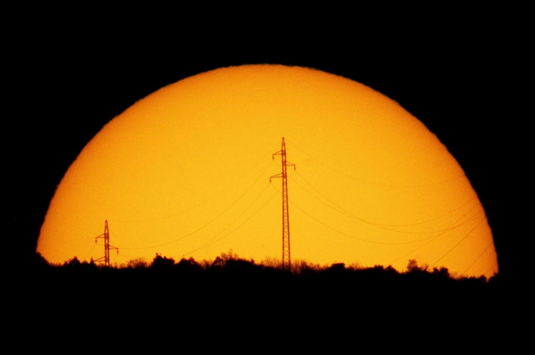Currently well-established in India, the backup power industry has grown rapidly during the last decade. Demand for alternative/backup power sources in the form of generator sets, power inverters, UPS, battery, etc. is expected to rise further in coming years.
 We all know Power is one of the important element for nation’s growth. India has grappled with a power deficit situation for several decades now. In fact, the power generation capacity addition has rarely been able to keep pace with the demand for power. An outdated Transmission and Distribution (T&D) network also results in high Aggregate Technical and Commercial (AT&C) losses as well as poor power quality. While proliferation of industrial, commercial, retail, and residential complexes result in increasing the overall power demand, growth in mission critical equipment results in requirement of high-quality reliable power.
We all know Power is one of the important element for nation’s growth. India has grappled with a power deficit situation for several decades now. In fact, the power generation capacity addition has rarely been able to keep pace with the demand for power. An outdated Transmission and Distribution (T&D) network also results in high Aggregate Technical and Commercial (AT&C) losses as well as poor power quality. While proliferation of industrial, commercial, retail, and residential complexes result in increasing the overall power demand, growth in mission critical equipment results in requirement of high-quality reliable power.
Several alternative sources of power have attained strategic importance while addressing this deficit and meeting power requirements. In fact, backup power has become a ‘way of life’ in India for majority users ranging from households to big commercial complexes, hospitals, datacenters, process industries, etc.
 Currently well-established in India, the backup power industry has grown rapidly during the last decade. Demand for alternative/backup power sources in the form of generator sets, power inverters, UPS, battery, etc. is expected to rise further in coming years.
Currently well-established in India, the backup power industry has grown rapidly during the last decade. Demand for alternative/backup power sources in the form of generator sets, power inverters, UPS, battery, etc. is expected to rise further in coming years.
Increased awareness and focus on green and nonpolluting sources, energy efficiency, and cost reduction are among the trends that will shape India’s backup power industry in years to come. Be it UPS for critical applications in the enterprise space, power inverters in homes and small offices, generator sets in industries, or batteries for numerous other applications, backup power is indispensable, given the importance of uptime and shortage of power.
Netscribes’ latest market research report titled Power Backup Market in India 2014 states the demand-supply gap in power distribution as the main reason for the boom in the power backup market. The power backup sector can be categorized into four broad segments, UPS, Diesel Generators, Inverters and Batteries. UPS segment has witnessed a consistent rise in demand owing to the rapid development of the IT sector along with growing consciousness among individuals to protect costly electronic equipments which can be adversely affected by sudden power failures. Demand for generator sets come from various sectors such as IT and ITes, telecom and construction while inverters are primarily used in households, shops and commercial establishments.
Manufacturing hub of the Indian power backup industry is concentrated in North India, particularly Himachal Pradesh, and Kolkata. Power deficit in the southern region of the country has triggered the demand for power backup in these regions. Tamil Nadu, Karnataka and Kerala generate the highest share of the overall demand for power backup in the country. Shortage in coal and gas, the primary raw materials for power generation, further aggravates the shortage in power supply. With time, consumers have emerged to be less tolerant about the duration of power cuts, thus providing tremendous growth prospects, which players can capitalize upon.
New Initiatives for Energy Storage Development
This month (July 2014), two major announcements by the Ministry of New and Renewable Energy (MNRE) and Power Grid Corporation of India Ltd (PGCIL) have opened doors for energy storage deployment for ancillary services and renewable integration in India.
Te lack of reliable and quality power supply is a major obstacle for accelerating development of manufacturing and industrial sector in India that is required to maintain 8-10% economic growth for the world’s largest democracy. Consumers bear a large burden due to poor quality and unreliable power supply. Industries maintain diesel powered generators and households have inverters with batteries as backup for unscheduled power cuts, low voltages or variable frequency.
Advanced Energy Storage systems can play a key role in every part of the modern grid in India.
The newly elected government in India has taken number of steps in past couple of months to fast track development of the energy infrastructure and set aggressive targets for continued renewable energy deployments in India.
Policy makers have taken some key initiatives that can drive grown of storage and microgrids:
- India is looking for rapid adoption of clean energy technologies with anticipated addition of 30-50 GW of new wind capacity and 20-30 GW of solar capacity by 2020.
- India has various initiatives for providing energy access where government of India provides up to 90% of the capital funding for building microgrids in rural areas with no access to electricity.
- Telecom Regulatory Authority of India has mandated use of renewable power for telecom towers in India that are currently utilizing diesel power as primary source of energy.
These policy initiatives have resulted in tremendous opportunities for integration of energy storage technologies for variety of applications. Advanced energy storage market in India is in its infancy however it carries significant market potential. A recent market assessment by India Energy Storage Alliance suggests a potential of 15-20 GW by 2020 in India.
Immediate applications range from telecom tower backups to grid ancillary services and renewable integration. The $300 million orders during 2013 by Indian Telecom Companies for purchasing Li-Ion batteries for telecom tower backup is a perfect example of the value proposition of the advanced storage technologies, and willingness of Indian businesses to adopt such technologies. Now with the RFPs issued by PGCIL and MNRE similar opportunities will open up for grid scale energy storage deployment.
India has also recently launched a National Mission on Electric Mobility with a target of 6 million electric vehicles (4 million two-wheelers and 2 million four-wheelers) by 2020. For efficient roll out of the EV program, electrical distribution infrastructure upgrades and smarter systems are required which will control or limit simultaneous charging of hundreds of EVs from the same feeder.
Beyond just timing the consumption of power, immediate policy level support is required to build enabling infrastructure to integrate the EVs in the electrical network so that these millions of EVs connected to the power system can be leveraged as virtual power plants (VPPs) that can store energy when there is surplus generation and support the grid during moments of deficit. Globally Vehicle to Grid (V2G) technologies are evolving rapidly that can achieve these objectives.
The rapid advancement in technology and the scale provided by growing Indian market coupled with localization potential can help drive down the cost of these emerging technologies.
High Reliability Power Backup With Advanced Energy Storage
Technological and market forces have converged to make energy storage one of the most exciting — and potentially game-changing — opportunities for commercial and industrial facility managers, grid operators, homeowners and investors.
 Forward-thinking utilities, battery suppliers, power inverter producers, system integrators and public-sector supporters are driving a massive expansion of energy storage solutions aimed at enabling the grid of the future — or even a grid-less future.
Forward-thinking utilities, battery suppliers, power inverter producers, system integrators and public-sector supporters are driving a massive expansion of energy storage solutions aimed at enabling the grid of the future — or even a grid-less future.
For mission-critical applications that require uninterrupted power, for example in industry or hospitals, it’s essential that the right standby power generation equipment is in place. With power grids having more and more demands placed on them, the continuity of mains supply can never be guaranteed.
Designing or selecting an uninterruptible power supply (UPS) can be tricky. Companies need to balance how important it really is for the UPS system to do its job – is it absolutely mission-critical, for example for a large investment firm or a telecoms basestation? Or could the company cope with occasional short outages, and the role of the UPS is to improve uptime in a cost-effective way? For many organizations, the UPS’s most important function is to protect equipment from damage in the event of a mains interruption, and to shut down in an orderly fashion In the past, the chosen short-term backup power solution has usually been batteries. These have predominately been lead acid, but today engineers have more options, including advanced Li-ion and NiMH battery technologies. Another solution is to use flywheels, but these are bulky and expensive, and also have reliability problems.
While these new battery technologies have made great advances and have been designed in to many solutions, they still present the same basic problem as lead acid batteries. They are based on a chemical reaction, which means that they suffer from a limited life, and can only operate in a limited temperature range. High current demands will also restrict their operating lifetime. For long-lasting, reliable applications this means there is a higher maintenance cost, and concerns about reliability.
An alternative solution is the ultracapacitor, an energy storage device that is well-suited for short-term power delivery such as bridge power. Also known as supercapacitors or Electrochemical Double Layer Capacitors (ELDC), they are not a new component, but the technology has advanced dramatically in the last 10-15 years.
Olivier Tremouille, Managing Director, Socomec
“Make in India concept will boost the industry segment”

The Indian market is a power deficient market and it has huge business potential especially in the Tier II and Tier III cities and towns. There are robust change in the demand from those areas from both consumers and enterprises. The total size of market is about 800 million dollar (Revenue).
The power condition in India is not stable and the quality of power supply is not as good as we see in other part of the globe. It’s important for customers with critical application like data centres, banking, ITES & Industries etc., to have an quality, uninterrupted power to run their operations smoothly for which they cannot rely on our grid supply and the UPS is able to meet their requirement. Sizeable demand from the IT/ITES, Government and Manufacturing sector is driving the growth of the UPS market. The need of urban mass transportation systems is also one of key driver of UPS market.
The UPS market is highly fragmented and is highly competitive. In recent years depreciation of Indian rupee against US dollar was major concern in the market as it is directly affecting the pricing strategy. The biggest challenges faced by UPS manufacturers will be cheap imports from China and Taiwan as well as rising raw material prices.
We are seeing a positive growth of our sales in industry, BFSI & hospitals segments, as earlier Indian UPS market are dominated mainly by IT, ITES & Data center business but in recent years we are seeing positive growth in the segment like Pharma, BFSI & Industries. Also the Make in India concept will boost the industry segment; therefore we will observe healthy demand of UPS in future.
Yogesh Dua, upsINVERTER.com
“India is falling short to meet the demands of rapidly growing economy and population”

Since the beginning of industrial revolution, power has become the most basic element required for any function in economy. Each segment of modern society is dependent heavily on power from domestic, agriculture, and industrial to service and governmental operations, all require electricity and energy to function.
With a growing population, especially that in urban areas, this new industrializing country (NIC) has increasing demands of electricity and power production. India currently ranks at fifth in the global scale in terms of the power sector. With an installed capacity of 2,07,006 MW, India is falling short to meet the demands of rapidly growing economy and population.
India’s power sector is one of the more ignored sectors in the Indian economy especially in the rural parts of the country remains without power, as does 6% of the urban population.
India suffers from an acute shortage of electricity and power, even after being the fourth largest consumer of electricity and power in the world. It is evident that, while supply of power and electricity in the country is increasing, it is not meeting current demands, let alone future demands. At current, the Indian power sector has an installed capacity of 2,07,006 MW, comprising of 66 percent from thermal, 3.7 percent from nuclear, 19 percent from renewable and alternate sources. While thermal power remains the highest sources of power, hydro is becoming a major player as well.
According to research data available from various sources, the problems in the power sector or power shortages apart from the obvious shortage in supply result from issues like:
- High Aggregate Technical and Commercial losses (AT &C Losses)
- Poor financial health of DISCOMs
- Shortage of fuel
- Low plant load factor
However, owing to India’s growing industrialization, the generation from power utilities has always been unable to keep pace with the rapidly growing demand. Hence, a large number of captive plants have been set up by industries to ensure reliable and quality growing demand.
“If we step it out for the solution then definitely problem will be solved without discussion over it.”
There are more than thousands of drivers fueling the demand of Power back-up. We UTL are possessing 14th position in 15 top UPS Inverter companies fueling the power demand by providing versatile products by electronics bazaar report (EFY Group).
There are various challenges today that these companies are facing. Some of them are Machineries, Raw materials, skilled manpower, land for manufacturing Plant etc.
The power backup supply cross over the demand soon. Our aim should not be only to increase the scope of Power backup Industries, but we must think about completion of all our needs with the existing power supply. For example we can consider LED lights which are highly energy saving w.r.t. CFL and Normal Light Bulbs. There are several products in the market which are costly, but it yields benefits in future that you could not know without awareness. Many of our products specially Online UPS and Solar UPS, PCU and Inverters (MNRE Approved) which is half energy consuming play the same role as LED light doing now-a-days. By using such less power consuming equipments and devices we can definitely save power and make the environment eco-friendly.
Mr. Ankesh Kumar, Director, Marketing, Emerson Network Power, India
“We see that customers continue to face problems with the quality of power.”

Even as India’s power sector is developing in terms of generation capacity and making improvements in power availability, we have not seen the UPS market being negatively affected. In fact, the demand for power backup and conditioning equipment has gradually gone up. We see that customers continue to face problems with the quality of power. Due to this, we have seen a gradual rise in demand from the UPS and battery market in India. Industries are taking a more proactive approach to power backup and conditioning equipment to gain better control over their equipment and improve reliability of their production plants while reducing costs.
A key factor that continues to drive the power backup and conditioning equipment space is that UPS solutions now have functions that make them capable of handling more complex tasks than simply enabling uptime. This has proven a boon for emerging IT companies. The rapid rise in consumer data consumption has been further driven by reliable and robust uninterrupted power supply solutions. This enables more efficient and reliable data storage/ management and other business processes that depend on UPS. Emerson Network Power is the leader by far in the 20kVA+ category as well as among the top players in smaller UPS and is well positioned for this.
As businesses widely adopt business critical equipment, they are increasingly bundling UPS systems with containment monitoring solutions. We see that buyer decisions are leaning more towards reliability and ease of integration. Solar is also another segment that will possibly see growth depending on the traction that renewable energy receives. Space optimization, which is permeating organizations of all sizes, is generating more demand for rack-based UPS systems for rack closets.
Perhaps the biggest challenge dominating this industry is the lack of awareness of basic power quality fundamentals and especially so for technologies powered by green initiatives including solar power. Often, users expect a UPS to automatically solve all power-related problems. Even after a UPS is installed, power problems can continue to occur as the root causes are often faulty earthing and grounding systems. Usage of poor quality batteries and cheap power systems from unorganized market makes high power systems unreliable. Regular power quality audits & monitoring that can prevent unplanned downtime and make UPS and other systems work efficiently, are not common in India.
That said, businesses continue to be on the lookout for reliable UPS systems as they cannot afford downtime. As is the case with any industry segment, innovation is the key to staying current and successful in a rapidly changing IT landscape and this drives Emerson Network Power to continually research and explore new methods to meet the power needs of customers.
While Emerson Network Power’s business has grown substantially in the recent past, we expect an increase in demand in the next 2-3 years as the Indian UPS market advances. We have observed several positive factors which will drive the growth of Industrial UPS in the coming time. We hope to see huge uptake demand for industrial UPS solutions in telecom, banking, insurance and healthcare segments.
We foresee that industries will start bundling UPS systems with containment monitoring solutions in an aggressive fashion and buyer decisions will lean more towards reliability and ease of integration. As renewable energy gains traction, solar options integrating with the power backup will become a force to be reckoned with. Solar Grid-Tied or Off –Grid would be standard inverter solutions available with smart controls to maximise the potential of solar energy. Emerson Network Power hopes to reinforce the Indian government’s mission of promoting ecologically sustainable growth while addressing India’s burgeoning energy security deficit.
Mr. Arun Ghosh, MD, CyberPower Systems India Pvt Ltd
“Customers are more focused and demand the latest technologies.”

The Indian power sector is facing an acute shortage, where the peak and non-peak electrical shortfalls were approximately between 9-10 per cent. Inadequate power generator, issues with land acquisition for new power plants, fuel shortage, and high transmission and distribution losses are some of the contributors to this situation. The increasing power deficit, the low and erratic quality of power supply and the unanticipated power cuts throughout the country are driving the growth of the backup power industry in India, of which UPS systems are major constituent. The scares of frequent Power cuts has compelled homes, organizations and industries to depend more and more on power back-up devices. UPS has become a need-base product today and people have started buying UPS and Inverters anticipating power cuts as nothing before.
The Indian UPS market is highly competitive, fragmented and fast growing, with both multinational and Indian suppliers competing for space. There are close to 300 organized suppliers of UPS systems in India. The demand for UPS system going up has significantly has led to a drop in prices. There are many upcoming products and market is flooding with variety of products for different applications.
Today the main expectations of the consumers, who are more aware of technology and other aspects than ever before, are looking for features such as quality, reliability, green performance, etc. when making products-related decisions.
Competition, Price, Quality, Demand & After-Sales-Service are the major verticals dominating the UPS market. In the years to come, the UPS market is expected to get more collocate; achieve greater standardization of products, and greater consumer awareness. The market is being consolidated globally and this is impacting India as well. Indian suppliers are exploring opportunities for collaboration with MNCs by forming joint ventures, and technical or distribution tie-ups to stay ahead in the market. This could lead to a win-win situation for both Indian companies as well as MNCs.
Reliability, Quality and Value, all made available through a wide distribution network, is the formula for success in the growing UPS market in India. Customers are more focused and demand the latest technologies. They are increasingly looking for product with higher backup time, space optimization, lowest MTTR (mean time to repair) and also remote monitoring for critical applications. UPS market has stepped into “intelligent integrated infrastructure“ solutions. This Intelligent solutions alerts users in case of any uncertainty occurs in the product. UPS market has also focused on increasing efficiency resulting in saving power and environment.
A UPS system is not just about backup power during contingencies, but is also about the quality of power. UPS systems also serve as power regulators, which prevent the undesirable effects of power anomalies and ensure that a constant amount of electrical power is supplied. Many electrical devices associated electronic that are connected to the UPS systems, are usually mission critical in nature and cannot be shut down unexpectedly. The upward trend in the Indian UPS market is expected to continue, with consistent growth projected over the coming 2-3 years as a result of steady demand from various end user sectors in the Commercial and Residential sectors.
Modular UPS Systems are gradually gaining prominence among end users and are slowly replacing conventional UPS systems, primarily due to the hot swappable feature, scalability and the flexibility they offer in terms of redundancy. The market is also moving towards high efficiency transformer-less UPS systems, especially in the 20 to 200 kVA Range and the above-200 kVA range, due to space constraints and also due to the growing trend of LEED (Leadership in Energy and Environmental Design) certification of buildings.






